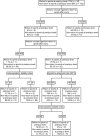Clinical Decision Algorithm Associated With Return to Sport After Anterior Cruciate Ligament Reconstruction
- PMID: 32396470
- PMCID: PMC7384465
- DOI: 10.4085/1062-6050-82-19
Clinical Decision Algorithm Associated With Return to Sport After Anterior Cruciate Ligament Reconstruction
Abstract
Context: Understanding the factors that predict return to sport (RTS) after anterior cruciate ligament reconstruction facilitates clinical decision making.
Objective: To develop a clinical decision algorithm that could predict RTS and non-RTS based on the differences in the variables after anterior cruciate ligament reconstruction.
Design: Cross-sectional study.
Setting: University laboratory.
Patients or other participants: A total of 150 athletes in any sport involving deceleration, jumping, cutting, or turning enrolled in the study. All participants answered the International Knee Documentation Committee and Anterior Cruciate Ligament Return to Sport After Injury (ACL-RSI) questionnaires and performed balance and isokinetic tests.
Main outcome measure(s): The classification and regression tree (CART) was used to determine the clinical decision algorithm associated with RTS at any level and RTS at the preinjury level. The diagnostic accuracy of the CART was verified.
Results: Of the 150 participants, 57.3% (n = 86) returned to sport at any level and 12% (n = 18) returned to sport at the preinjury level. The interactions among the peak torque extension at 300°/s >93.55 Nm, ACL-RSI score >27.05 (P = .06), and postoperative time >7.50 months were associated with RTS at any level identified by CART and were factors associated with RTS. An ACL-RSI score >72.85% was the main variable associated with RTS at the preinjury level. The interaction among an ACL-RSI score of 50.40% to 72.85%, agonist : antagonist ratio at 300°/s ≤63.6%, and anteroposterior stability index ≤2.4 in these participants was the second factor associated with RTS at the preinjury level.
Conclusions: Athletes who had more quadriceps strength tended to RTS at any level more quickly, even with less-than-expected psychological readiness. Regarding a return at the preinjury level, psychological readiness was the most important factor in not returning, followed by a better agonist : antagonist ratio and better balance.
Keywords: classification and regression tree; muscle strength; postural balance; prediction rules.
© by the National Athletic Trainers' Association, Inc.
Figures



References
-
- Toole AR, Ithurburn MP, Rauh MJ, Hewett TE, Paterno MV, Schmitt LC. Young athletes cleared for sports participation after anterior cruciate ligament reconstruction: how many actually meet recommended return-to-sport criteria cutoffs? J Orthop Sport Phys Ther. 2017;47(11):825–833. - PubMed
-
- Ardern CL, Webster KE, Taylor NF, Feller JA. Return to the preinjury level of competitive sport after anterior cruciate ligament reconstruction surgery: two-thirds of patients have not returned by 12 months after surgery. Am J Sports Med. 2011;39(3):538–543. - PubMed
-
- Ardern CL, Webster KE, Taylor NF, Feller JA. Return to sport following anterior cruciate ligament reconstruction surgery: a systematic review and meta-analysis of the state of play. Br J Sports Med. 2011;45(7):596–606. - PubMed
-
- Ardern CL, Taylor NF, Feller JA, Webster KE. Fifty-five per cent return to competitive sport following anterior cruciate ligament reconstruction surgery: an updated systematic review and meta-analysis including aspects of physical functioning and contextual factors. Br J Sports Med. 2014;48(21):1543–1552. - PubMed
MeSH terms
LinkOut - more resources
Full Text Sources
Medical

